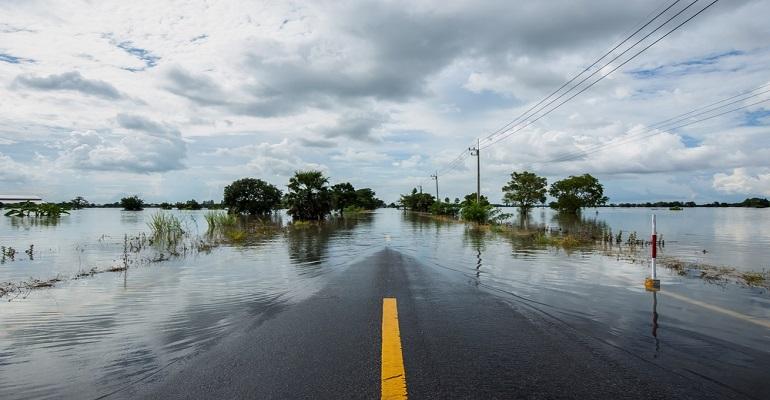The increasing volatility of global and regional weather patterns has meant that cities are having to roll out urgent climate mitigation strategies to safeguard themselves against the effects of extreme climate change.
With Dubai experiencing unprecedented torrential rains and floods earlier this year, the government is looking to aggressively roll out flood infrastructure while mitigating damage associated with rain. Prioritising infrastructure investment is already on top of the emirate’s list, including flood barriers, construction of drainage systems and retention ponds as well as instituting early warning systems and weather monitoring technologies.
Architects, and urban and city planners are being roped into conversations to lend their expertise as they discuss the need for resilient urban planning and infrastructure to handle extreme weather patterns.
CLIMATE MITIGATION
In a recent interview with Dubai Eye’s Georgia Tolley, award winning climate activist and Head of Innovation and ESG at AECOM, Farah Naz, said the cost of non-action when it comes to storms and floods is really high. Drawing on a case study in Miami in 2021, where AECOM was hired to assess storms and its effects on the state, the team found that Miami’s USD 92 billion tourism industry could be at risk of major storm damage over the next few decades.
“If there is a 10% chance of a storm by 2040, the cost for the state of Miami for a single storm will be around USD 3.2 billion and by 2070 it could be USD 16.5 billion. So, the question is what is the cost of non-action?” said Naz.
“How do we address climate challenges? This year is already the hottest year in 175 years of climate data with April being the hottest. The day the UAE, Dubai had these storms, there were other parts of the world that also experienced similar catastrophes. So, what do we do? There is the immediate short-term action that looks at stranded assets then looking at the mid-term options of blue and green infrastructure and long-term strategies, there is a phased way of looking at climate mitigation specifically for different parts of the world and specifically for Dubai,” she said.
Naz emphasised the use of blue and green infrastructure when it comes to implementing climate mitigation strategy due to its potential to address and reduce global challenges such as climate change, and discussed how regional best practices like Expo City Dubai is a good example of this as it represents a microcosm of a climate smart city.
“The concepts of smart city have evolved from just being smart with technology to being climate smart and adapt to a changing climate because so much of it is unpredictable,” said Naz.
Naz pinpointed Expo’s Tera Pavilion as an ideal example, saying that it has an inbuilt water and energy infrastructure which includes reed beds, gardening and landscaping that are designed to withstand against storms. “Having different layers of mitigation helps. Rain gardens, storage tanks, underwater tanks, helps slow down how fast water is going to move during a storm and slowing down the race of water is critical to a storm water plan,” she told Tolley.

For Naz this type of planning is essential because it forms part of the green corridors spelled out in Dubai’s 2040 Urban Master Plan. “These green corridors have the potential to become blue and green infrastructure creating a climate mitigation plan not just for Dubai today but for Dubai in a 100 years and that’s how you make cities of the future.”
BAREFOOT SOCIAL ARCHITECTURE
Looking at global efforts; following devastating floods in Pakistan in 2022 causing close to USD 24 billion worth of damage, architect Yasmeen Lari vowed to build one-million flood-resilient homes by 2024. The homes are flood-resilient, locally sourced, made with lime render and bamboo, zero carbon and zero waste and part of what Lari calls barefoot social architecture, a self-built approach that supports marginalised communities. Lari and her Heritage Foundation have so far provided 333, 000 homes since her pledge.
Lari, widely celebrated as Pakistan’s first female architect, founded the Heritage Foundation of Pakistan in 1980 and over the last few years has invested in teaching women to build flood resilient bamboo shelters and enabling them to teach other women in the village.
Her passion and advocacy spans years and earned her the RIBA Royal Gold Medal in 2023 for her work in social architecture. For Lari, a climate-resilient, healthy environment is a boon for all inspiring all aspects of a city to function from tourism to commerce.
Penning an article in Dezeen on designing for disaster, Lari says: “By adopting the above simple principles and low tech, low impact options, many urban centres of the world would be able to mitigate the impact of climate change and would become liveable again.”
MAKING CITIES CLIMATE READY
Looking at global efforts, for US-based landscape architect and climate activist Martha Schwartz, founder of Martha Schwartz Partners, understanding how cities are built is crucial to the planet’s survival. Her work centres around the urban landscape and the importance of making cities climate ready and mitigating the effects of climate change.
A lecturer at Harvard University, Schwartz recently delivered a lecture to Green Riyadh following an invitation by the Royal Commission for Riyadh City. Here she talked about climate change and its effects on cities, tackling how the role of architecture is essential in combatting the urban heat island effect and introducing the concept of the linear urban forest. Like Lari, Schwartz is an advocate for the Miyawaki method, one of the most effective tree planting methods for creating forest cover quickly and part of Schwartz’s plan to build an urban forest.
Cityscape WIRE is MENA's networking community, fuelling women's careers in the real estate industry. Find out more and join the community!



